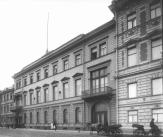Addresses
/
Dvortsovaya Embankment/Saint Petersburg, city
hidden
|
Diplomatic missions (entry)
DIPLOMATIC MISSIONS, foreign governmental organs of external affairs headed by an ambassador of an embassy, a missionary, or a diplomat appointment to a particular mission. In 1709, the Danish missionary came to St
|
|
|
|
|
hidden
|
Dvortsovaya Embankment
DVORTSOVAYA EMBANKMENT (Palace Embankment), called Verkhnaya Naberezhnaya Street or First Verkhnaya Embankment beginning in 1738; in the 1740s-90s, it was known as Millionnaya Embankment; from 1923 to 1944 it was called Devyatogo Yanvarya Embankment
|
|
|
|
|
hidden
|
Ermitazhny (Hermitage) Bridge
ERMITAZHNY (HERMITAGE) BRIDGE (in 1738 Naberezhny, in the middle of the 18th century known as Verkhnenaberezhny, or Zimnedvortsovy; was also called Dvortsovy (Palace) until 1828), across Zimnyaya Kanavka along Dvortsovaya Embankment
|
|
|
|
|
hidden
|
Felten Y. M. (1730-1801), architect
FELTEN Yury Matveevich (Georg Friedrich) (1730 -1801, St. Petersburg), architect, professor of the Academy of Fine Arts (from 1775; from 1785 a Council member, in 1789-94 director), State Counsellor (1784)
|
|
|
|
|
hidden
|
Kutuzova Embankment
KUTUZOVA EMBANKMENT, located on the left bank of the Neva River, running from Liteiny Avenue to the Fontanka River Embankment. In the 18th - first half of the 19th centuries, it formed a part of the Dvortsovaya Embankment; from 1860
|
|
|
|
|
hidden
|
Landings, Water (entry)
LANDINGS, WATER. Ship landings were present in St. Petersburg from the first years of its existence. Their location depended on the location and orientation of storage warehouses
|
|
|
|
|
hidden
|
Lebyazhy Bridges
LEBYAZHY BRIDGES, two bridges spanning Lebyazhy Canal. The Nizhne-Lebyazhy Bridge (Lower Lebyazhy Bridge, formerly the first Tsaritsynsky, after Tsaritsyn Medow, see the Field of Mars) is on the Moika River Embankment
|
|
|
|
|
hidden
|
Memorial plaques (general article)
MEMORIAL PLAQUES. Memorial inscriptions in stone and metal first appeared in St. Petersburg as early as the 18h century. On the descents leading to the Neva River
|
|
|
|
|
hidden
|
Moshkov Lane
MOSHKOV LANE named Zaporozhsky Lane after a Ukrainian city in 1952-89, between Dvortsovaya Embankment and Moika River Embankment. It was laid in the first quarter of the 18th century and named after houseowner and Master of the Household P. I
|
|
|
|
|
hidden
|
Prachechny Bridge
PRACHECHNY BRIDGE, over the Fontanka River, by its outlet from the Neva, linking the Dvortsovaya Embankment and Kutuzova Embankment. The name of the bridge refers to Prachechny Yard (Laundry Yard
|
|
|
|
|
hidden
|
Summer Garden
SUMMER GARDEN (Dvortsovaya Embankment), an 18th-19th century landscaping monument. It is the oldest city garden in the central part of St. Petersburg, and is situated on the left bank of Neva, on an island formed by Fontanka River
|
|
|
|
|
hidden
|
Toponymy of St. Petersburg
TOPONYMY OF ST. PETERSBURG, a corpus of names of geographical points situated on the territory of St. Petersburg. Names of rivers, islands, and villages located on the city's future territory appeared long before its foundation
|
|
|
|
|
hidden
|
Tramway
TRAMWAY (borrowed into Russian as the word derived from English tram (carriage) and way), a means of city rail transport. Three kinds of tramways are known: horse-drawn (see Horse-tram)
|
|
|
|
|





















